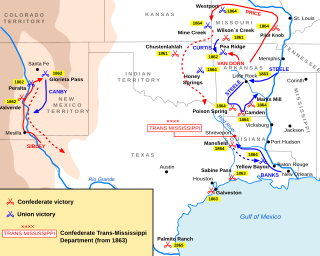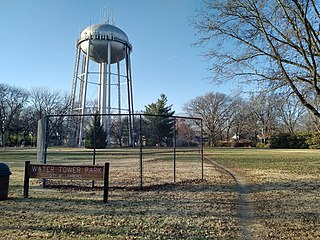In June 1862 two Union camps were established in the vicinity of what is today Baxter Springs, Kansas. One was Camp Hunter, located in what is now the center of the town. The other was the Indian Home Guard Camp, located at Little Five Mile Creek, 1½ miles southeast of Camp Hunter.

Baxter Springs is a city in Cherokee County, Kansas, United States, and located along Spring River. As of the 2010 census, the city population was 4,238; it is the most populous city of Cherokee County.
Camp Hunter was established in June 1862 or a bit earlier at what is now Baxter Springs, Kansas. It was established by Union troops. At the same time Indian Home Guard regiments established a camp nearby on Little Five Mile Creek.
The area where the Indian camp was located was flat ground. Little is known about the camp. Hugh Thompson, who was stationed as a scout in the area, said 6,000 men were stationed between the Indian camp and Camp Hunter in June 1862. The 2nd Regiment of the Indian Home Guard was organized there and placed under the command of Col. John Ritchie. This regiment was organized from June 22 to July 18. It took so long to organize because of various political disagreements amongst the government negotiators.
John Ritchie was an American abolitionist in Kansas who served in the Union Army during the American Civil War
The camps at Baxter Springs were established with three goals in mind. One was to escort wagon trains heading south into Indian Territory, as much of that entity was held by Indians owing loyalty to the Confederacy. Therefore, wagon trains traveling through the Indian Territory were in danger of being attacked. [1]

As general terms, Indian Territory, the Indian Territories, or Indian country describe an evolving land area set aside by the United States Government for the relocation of Native Americans who held aboriginal title to their land. In general, the tribes ceded land they occupied in exchange for land grants in 1803. The concept of an Indian Territory was an outcome of the 18th- and 19th-century policy of Indian removal. After the Civil War (1861–1865), the policy of the government was one of assimilation.
A second goal was to provide a good place to rest tired cavalry horses. There was much tall native prairie grass just west of the camps. The troops in the camps were needed to guard the resting horses.
A third goal was to have troops in the area to contest the activities of Bushwhackers and Confederate Indians who operated in the area. [2]
As soon as both camps were established, acction was taken to uproot a guerrilla camp commanded by Capt. Thomas Livingston. The camp was overrun, but Livingston and his men escaped. Further attempts to capture or destroy the guerrilla force ended in failure. When attacked, the guerrillas would disappear. It was discovered after the Civil War they had a hidden camp on the border with Missouri. (See Livingston's Hideout.) [3]
Livingston's Hideout was most likely the only permanent Confederate military camp inside Kansas during the Civil War. It was in the very corner of southeast Kansas, in the very corner of Cherokee County, Kansas. It was about 2 miles (3.2 km) north of the border with Indian Territory and it was less than 100 feet (30 m) west of the border with Missouri. It was 5 miles (8.0 km) west of Baxter Springs, where a series of Union military posts existed from 1862 to 1863. Thomas R. Livingston became a leader of a group of Confederate guerrillas in the area, becoming first a captain and then a major. He needed locations to hide himself and his guerrillas from pursuing Union troops and this hideout suited the guerrillas well. The guerrillas sought to spy on Union forces and raiding units he found small enough to defeat.
The white soldiers were at first skeptical of the abilities of the Home Guards. They wore mismatched uniforms and wore stovepipe hats, looking little like soldiers. Their ponies were so small the riders' feet almost touched the ground when they rode. Someone said it appeared the Indians were walking as they were riding. However, the Indians proved themselves well in battle. Their ponies proved useful, as they were well adapted to the summer heat and did not wear out, as did many of the larger horses of the white troops. [4]
In early September Camp Hunter and the Indian Home Guard camp found themselves on the front line. The soldiers were warned of an approaching Confederate regiment. Both camps were quickly abandoned. Camp Hunter was briefly occupied by the Confederate force. After the Confederate force and possibly other Confederates shortly later passed through, neither camp was used again. [5]






